
Mecklenburg-Vorpommern, also known by its anglicized name Mecklenburg–Western Pomerania, is a state in the north-east of Germany. Of the country's sixteen states, Mecklenburg-Vorpommern ranks 14th in population; it covers an area of 23,300 km2 (9,000 sq mi), making it the sixth largest German state in area; and it is 16th in population density. Schwerin is the state capital and Rostock is the largest city. Other major cities include Neubrandenburg, Stralsund, Greifswald, Wismar, and Güstrow. It was named after the two regions of Mecklenburg and Fore Pomerania.
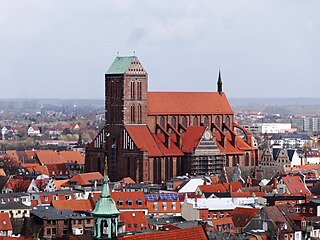
Wismar, officially the Hanseatic City of Wismar is, with around 43,000 inhabitants, the sixth-largest city of the northeastern German state of Mecklenburg-Vorpommern, and the fourth-largest city of Mecklenburg after Rostock, Schwerin and Neubrandenburg. The city was the third-largest port city in former East Germany after Rostock and Stralsund.

Rostock, officially the Hanseatic and University City of Rostock, is the largest city in the German state of Mecklenburg-Vorpommern and lies in the Mecklenburgian part of the state, close to the border with Pomerania. With around 210,000 inhabitants, it is the third-largest city on the German Baltic coast after Kiel and Lübeck, the eighth-largest city in the area of former East Germany, as well as the 39th-largest city of Germany. Rostock was the largest coastal and most important port city in East Germany.

Güstrow is a town in Mecklenburg-Vorpommern in north-eastern Germany. It is capital of the Rostock district; Rostock itself is a district-free city and regiopolis.

Ribnitz-Damgarten is a town in Mecklenburg-Vorpommern, Germany, situated on Lake Ribnitz. Ribnitz-Damgarten is in the west of the district Vorpommern-Rügen.

Rostock Airport, German: Flughafen Rostock-Laage, is the airport of Rostock, the largest city in the German state Mecklenburg-Vorpommern, and is named after Laage, within the boundary of which it is located. Laage is a town in the Rostock district. It features flights to major cities throughout Germany as well as some leisure routes. In addition to civil activity, Jagdgeschwader 73 of the German Air Force is stationed on the military side of the airport.

The Recknitz is a river in Mecklenburg-Vorpommern in northeastern Germany. The Recknitz's glacial valley stretches as far south as the heights at Glasewitz near Güstrow. The river has no definite source, but rather builds up from streams and drainage ditches. The ditches of the Schaalbeke and Pludderbach have their water flow split between Liessow and Laage, but most of the water flows north as the Recknitz, while the lesser flow, called the Augraben, runs south to the river Nebel.

Bad Sülze is a town in the Vorpommern-Rügen district, in Mecklenburg-Western Pomerania, Germany. It is situated on the river Recknitz, 35 km southwest of Stralsund, and 35 km east of Rostock.

Schwaan is a municipality in the Rostock district, in Mecklenburg-Vorpommern, Germany. It is also the seat of the Schwaan Township, serving another six municipalities.

Tessin is a town in the Rostock district, in Mecklenburg-Western Pomerania, Germany. It is situated on the river Recknitz, 22 km east of Rostock.
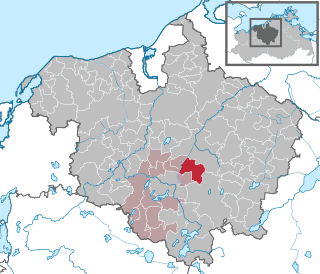
Plaaz is a municipality in the Rostock district, in Mecklenburg-Vorpommern, Germany. It is situated close to the cities Güstrow, Laage and Teterow. Plaaz includes several villages such as Mierendorf, Wendorf and Zapkendorf. As of January 2005, both Spoitgendorf and Recknitz are incorporated in this municipality.
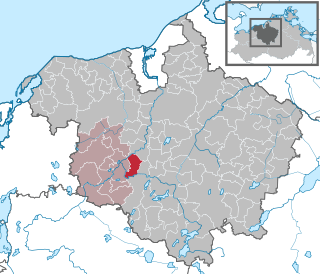
Zepelin is a municipality in the Rostock district, in Mecklenburg-Vorpommern, Germany. It is part of the Amt Bützow Land.

Dettmannsdorf is a municipality in the Vorpommern-Rügen district, in Mecklenburg-Vorpommern, Germany. The municipality is located south-west of Ribnitz-Damgarten in the Recknitz valley. Until January 1, 1999, it belonged to Amt Trebeltal and now belongs to Amt Recknitz-Trebeltal.

The Neustrelitz–Warnemünde Railway is a railway line in the North German state of Mecklenburg-Vorpommern. Most of the line is a double-tracked, electrified main line and runs for almost 130 kilometres from Neustrelitz to Warnemünde. It is also known in German as the Lloydbahn, referring to the Deutsch-Nordischer Lloyd company, which built the line and operated it in its early years after its opening in 1886.
Rostock is a district in the north of Mecklenburg-Vorpommern, Germany. It is bounded by the district Nordwestmecklenburg, the Baltic Sea, the district-free city Rostock and the districts Vorpommern-Rügen, Mecklenburgische Seenplatte and Ludwigslust-Parchim. The district seat is the town Güstrow.
The region of Middle Mecklenburg represents that area of the German state of Mecklenburg-Vorpommern with the most developed infrastructure in a state that is otherwise rather underdeveloped structurally. Middle Mecklenburg includes the largest urban centre in the state, the Hanseatic city of Rostock with its 200,000 inhabitants together with the surrounding district of the same name. The most important river in the region is the Warnow. Its transport links radiate from Rostock in a star configuration and the metropolitan region of the port city is served by a public transport network that includes the Rostock S-Bahn. Other important centres are the county towns of Bad Doberan and Güstrow. The main tourist attraction is the Baltic Sea coast along the Bay of Mecklenburg with the Salzhaff, the sea cliffs and the seaside resorts of Rerik, Kühlungsborn, Heiligendamm, Warnemünde and Graal-Müritz. In the south Middle Mecklenburg transitions into the naturally very unspoilt region of the Mecklenburg Lake District. In the east the River Recknitz forms its boundary with West Pomerania, in the west it merges gradually into West Mecklenburg.
Kyra T. Inachin was a German historian.
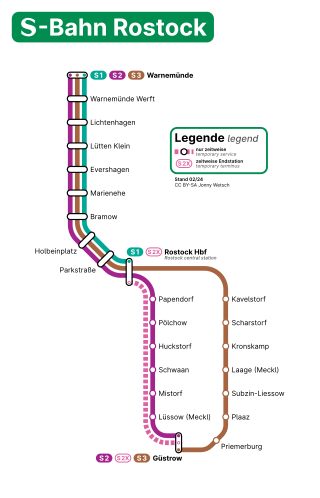
The Rostock S-Bahn is a S-Bahn network in Rostock in the German state of Mecklenburg-Vorpommern. It consists of three lines with a total length of about 90 km. Line S1 runs from Rostock Hauptbahnhof to Warnemünde within the Rostock urban area. S-Bahn operations started on 28 September 1974. Later, the lines to the north-east to the port (Seehafen) of Rostock and to the south to the town of Güstrow via Schwaan were included in the S-Bahn network. The line to the port was discontinued in 2012, but at same time the line to Güstrow via Laage was included as line S3 of the S-Bahn. Until 2014 the rolling stock mainly consisted of push–pull trains with Waggonbau Görlitz double-deck coaches. Since then all lines have been operated with new Bombardier Talent 2 railcars.
Paul Wallat was a German landscape artist, draftsman and sculptor.
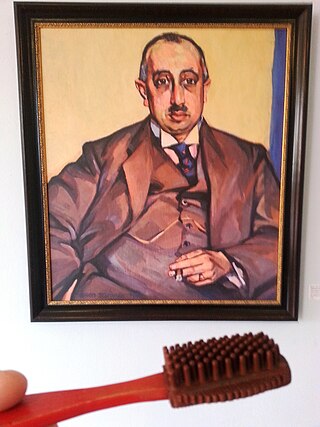
Max Samuel was a German businessman and self-made man, founder and managing-director of the EMSA-Werke, chair of the Jewish congregation in Rostock and head deputy of the Israelite Upper Council of Mecklenburg-Schwerin.


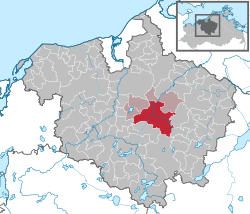




![Town Hall [de] Rathaus Am Markt 7.JPG](http://upload.wikimedia.org/wikipedia/commons/thumb/f/fb/Rathaus_Am_Markt_7.JPG/220px-Rathaus_Am_Markt_7.JPG)


















